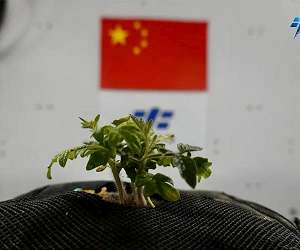Antarctica’s McMurdo Dry Valleys contain some of Earth’s coldest and driest deserts. The environment there is so extreme that the Dry Valleys have been used as Mars analogs to test prototype equipment for future Mars exploration. To survive these harsh conditions, layers of algae and bacteria in the Dry Valleys overwinter in a freeze-dried state, coming back to life in the summer when neighboring glaciers melt and water flows down the stream channels again. The algae are so hardy that some scientists think they could be well suited to the harsh conditions of space flight, where they could scrub carbon dioxide from the air, produce oxygen and provide food for astronauts.
The algae’s cycle of stasis and renewed growth caught the attention of Emily Matula, who was a bioastronautics doctoral student at the University of Colorado Boulder when the research was conducted.
“I was interested in looking at how we could potentially use these different algal species that have adapted to these extreme environments in spaceflight systems,” said Matula.
This sparked a collaboration with Antarctic researcher Diane McKnight. The researchers used DNA sequencing to characterize the species of green algae that grow as mats in the McMurdo Dry Valleys’ meltwater streams. Matula and McKnight will present findings on the algae and bacteria species that make up these mats on Monday, Dec. 12 at AGU’s Fall Meeting in Chicago and online everywhere.
Space-Faring Algae
Spacecraft engineers are interested in using algae to close a spacecraft’s carbon loop: Algae could produce oxygen and turn carbon dioxide respired by astronauts into biomass that the astronauts then eat and respire back to carbon dioxide. A closed-loop spacecraft would not need to be resupplied from Earth, which would increase how far and for how long humans could travel through space. According to Matula, the same water piping that is currently used to make cabin temperatures survivable for a spacecraft’s crew could serve double duty by both growing algae and regulating temperature.
Large, daily temperature oscillations in the piping create harsh conditions for most algae and are the biggest challenge to overcome when using the piping to grow algae aboard spacecraft.
“Sure, we have a readily available ‘lab rat’ algae, but when you expose them to more extreme environments, the majority of them are stressed or die,” said Matula. “So, if the algae are going to be exposed to the extreme environments of space travel, you probably want a species that is better equipped to survive.”
Matula and McKnight think that the green algae growing in the McMurdo Dry Valley mats might be the algae that space explorers are looking for. These green algae are well-adapted to large temperature fluctuations similar to those found in spacecraft plumbing, swinging from 4 degrees Celsius (39.2 degrees Fahrenheit) to 15 degrees Celsius (59 degrees Fahrenheit) in a single summer day, McKnight said.
But not all algae are equally flexible, so to find the algae best suited to spaceflight conditions, Matula and McKnight needed to know what was living in those hardy green mats.
“We didn’t know which would be the best stream to find the green algae best adapted to temperature fluctuations and how the mats vary from one stream to another,” said McKnight.
To characterize the algae species in the green mats, Matula and McKnight sequenced the DNA from active, green algae initially collected from eight meltwater streams in the Dry Valleys. They also tried growing one Antarctic algae culture in the same laboratory conditions as their “lab rat” algae, so that they could compare the different species’ ability to withstand the fluctuating temperatures typical of the temperature-control piping in spacecraft.
According to McKnight, her team is still working to determine how the algal communities vary between the different streams and how they compare to the algae communities that developed in their laboratory cultures. McKnight did share one clear, preliminary finding: Their cultures were dominated by a narrow group of algae that have been observed in other Antarctic environments before. Growing Antarctic algal species in the lab is a starting point for the research team to better understand how Antarctic algae tolerate oscillating temperatures on daily and seasonal cycles.
The team is planning further experiments to determine how the algal communities vary between the studied streams, how quickly their algae revive from cryostasis, and how algal growth can be optimized in a spacecraft’s environment.
Research Report:Microbial Composition of Chlorophyte-dominated Mats in Glacial Meltwater Streams in the McMurdo Dry Valleys, Antarctica
Related Links
University of Colorado Boulder
Space Tourism, Space Transport and Space Exploration News
|
We need your help. The SpaceDaily news network continues to grow but revenues have never been harder to maintain. With the rise of Ad Blockers, and Facebook – our traditional revenue sources via quality network advertising continues to decline. And unlike so many other news sites, we don’t have a paywall – with those annoying usernames and passwords. Our news coverage takes time and effort to publish 365 days a year. If you find our news sites informative and useful then please consider becoming a regular supporter or for now make a one off contribution. |
||
|
SpaceDaily Monthly Supporter $5+ Billed Monthly |
SpaceDaily Contributor $5 Billed Once credit card or paypal |
|

![]()
Plant on China’s Shenzhou-15 spaceship begins growing
Beijing (XNA) Dec 06, 2022
The Arabidopsis thaliana plant boarding on China’s Shenzhou-15 manned spaceship has begun growing, the China Science and Technology Daily reported on Monday.
The Shenzhou-15 spaceship was launched at 11:08 p.m. on Nov. 29, 2022. About 20 hours later, Chinese astronauts placed the Arabidopsis thaliana in a biological incubator in the life and ecological experiment cabinet inside the Wentian lab module of China’s space station.
“We are using the Arabidopsis thaliana grown in microgravity to ex … read more